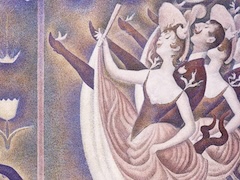Landscape Island of the Grande Jatte by Georges Seurat

This landscape inevitably brings to mind the large final composition with its many figures, and it may therefore seem unpeopled, somehow desolate. We should nonetheless try to take it on its terms and nor treat it simply as a study. Claude Monet and other landscape artists frequently painted parks and meadows without prominent figures, so Seurat was not being markedly unusual here. Three boats animate the water and signal this area as a place of leisure, and a dog in the distance gives perspective to the broad greenward. It is "empty" only in the sense of being a landscape destined for strollers and picnickers who are absent for the moment; it is a piece of nature that has been manicured into a serviceable pattern.
Originally exhibited in December 1884, with the Indépendants, this canvas was reworked not long afterward, probably before its second exhibition (spring 1886 in New York). The painted border was added later, apparently in 1889 or 1890. In 1884 the canvas would have lacked the many small dabs that now are found across the shaded and sunlit grass and in the shaded portions of the distant trees. We can still see its original fracture in the sky, the water, and the sunny foliage of the trees, as well as in those areas of the grass (for example, below and to the left of the nearest tree) that were not reworked. For the water Seurat emulated Monet's technique of squeezing out much of the oil from his paint, then dragging it sideways so that the canvas's vertical threads caught the thickened paint, creating a corduroy effect. The result is a shimmer that works well with the horizontal strokes to simulate the look of gently agitated water.
For the sunlit grass, Seurat first brushed in light brownish green in relatively large strokes; he then went over it with smaller touches of several greens, yellow-green, light creams, and oranges. For the shaded grass, he followed the same procedure: first deep greens to establish the local color, then several tints of green, blue-green, blue, and wine red. When he reworked the picture, probably before mid-autumn 1885, he used smaller strokes principally to add contrasting hues, especially the solar orange sprinkled over the shaded grass and the pinks that oppose the bluish purples.
















